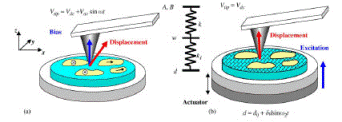Department of Physics and Astronomy: Publications and Other Research

Alexei Gruverman Publications
Document Type
Article
Date of this Version
9-1-2002
Abstract
Piezoresponse force microscopy has been used to investigate the nanoscale mechanism of imprint behavior of ferroelectric PbTiO3 thin films by studying the photoinduced changes in the hysteresis loops of individual grains. Illumination of the film with UV light resulted in a voltage shift opposite to that observed in ferroelectric thin film capacitors. This effect is attributed to the generation of an electric field within the surface dielectric layer as a result of the interaction between photo-induced charges and polarization charges. Application of a small non-switching bias to the film with simultaneous UV illumination resulted in domain pinning in the grains where the polarization direction coincided with the direction of the applied field, in agreement with the proposed model. Domain pinning was also observed in grains with polydomain structure suggesting that charge entrapment at the existing domain boundaries in the bulk of the film contributes to the suppression of switchable polarization. However, a symmetric character of hysteresis loops observed in such grains implies that charge entrapment in the bulk of the film does not cause the voltage shift. It has been suggested that a thin high-dielectric interfacial layer can improve the imprint behavior of ferroelectric capacitors.


Comments
Published in J. Appl. Phys., Vol. 92, No. 5, 1 September 2002. Copyright © 2002 American Institute of Physics. Used by permission.